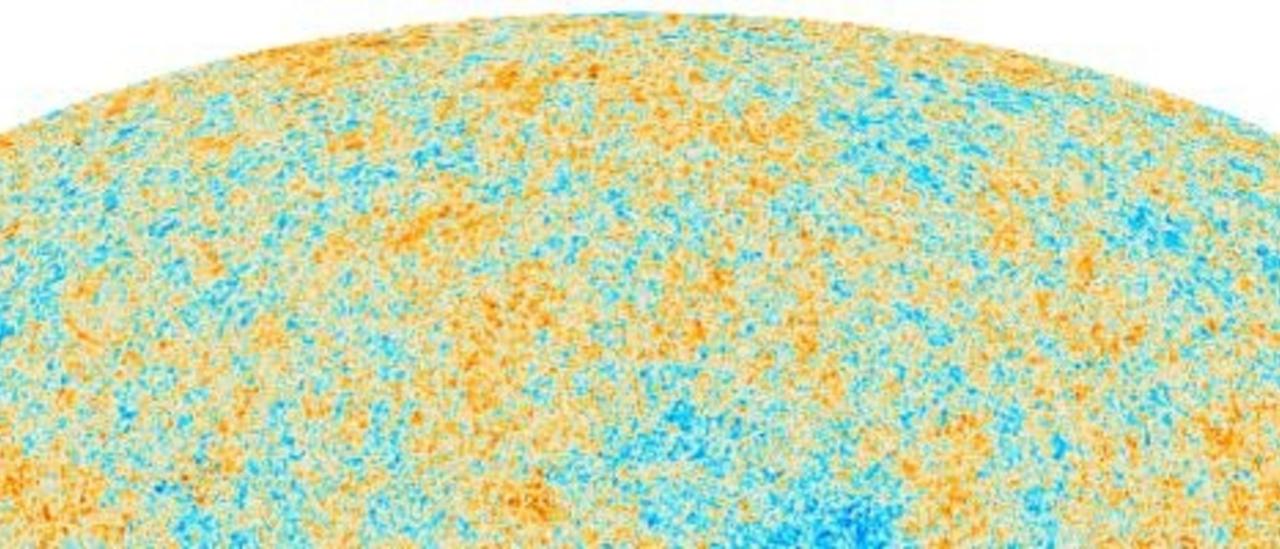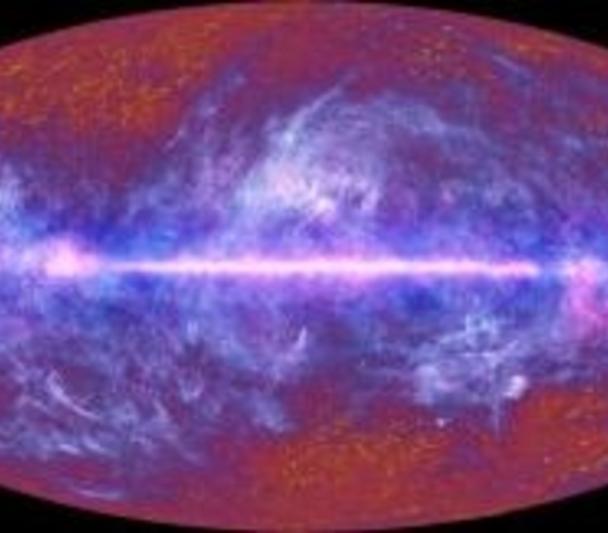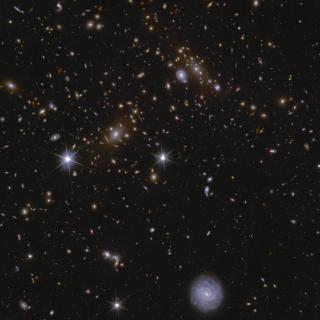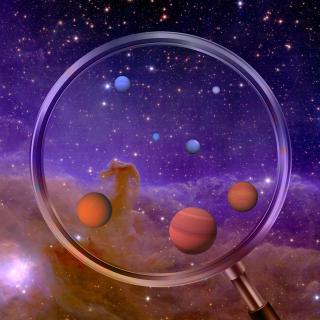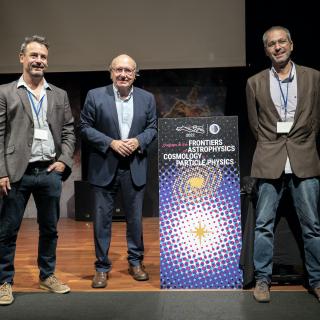General data
Astroparticle physics: cosmic-rays and gamma-rays.
The Astroparticle physics group at the IAC aims to study cosmic- and gamma-rays sources, exploring the Early Universe, the dark ages and the nature of dark matter and dark energy. It is involved in two major collaborations: The Alpha Magnetic Spectrometer (AMS) at the International Space Station (ISS) and the MAGIC Telescopes for gamma radiation.
AMS will provide knowledge of the spectrum and chemical composition of the cosmic rays at a level not known before. The IAC aims to use the AMS data to study the cosmic-rays acceleration mechanisms in action in the most extreme astrophysical environments (supernovae remnants, pulsars, black holes, etc.) and to understand the cosmic-ray chemical evolution in our Galaxy produced by spallation processes in the interstellar medium (primary species like C, N and O transform into light secondary species like Li, Be and B). AMS data combined with complementary observations of very-high energy (VHE) gamma ray photons with the MAGIC telescopes, will provide new key insights on cosmic and gamma ray sources. In collaboration with the MAGIC we also aim to study high redshift cosmic ray nuclei and carry out indirect searches for dark matter using these experiments.
There have been also important activities in promoting the Canarian Observatories candidacy to host the CTA-North observatory. In 2016 Spain and Japan agreed on the installation of four new Cherenkov telescopes, which may form part of the future CTA-North, at the Roque de los Muchachos Observatory, on the island of La Palma.
Cosmology
The Severo Ochoa project is also supporting the major center goals in the Cosmology research line:
- Exploring the Physics of the Early Universe and primordial gravitational waves. The study of the temperature and polarization anisotropies of the relic Cosmic Microwave Background (CMB) radiation is an essential tool to understand the physical properties of our Universe and its evolution. A unique confirmation of the existence of an inflationary episode in the Early Universe at energy scales of 10^16 GeV (12 orders of magnitude larger than those achievable at CERN) can be obtained by its imprint in the polarization of the CMB. The cosmology Group at the IAC is involved in two key projects at the frontier of this field: the ESA´s Planck mission, and the QUIJOTE-CMB Experiment (R. Rebolo is co-I and PI respectively) aimed to set major constraints on the inflationary period of the universe and the generation of primordial gravitational waves.
- Observational constraints on the nature of the dark energy with massive spectroscopic surveys of the distant Universe. What is the dark energy? Is it Einstein´s cosmological constant, or is it a dynamical phenomenon with a (measurable) degree of evolution? These questions can only be addressed using astrophysical probes. IAC is involved in a series of experiments (Planck satellite, the SDSSIII – BOSS project, the eBOSS, and the ESA´s Euclid satellite) which will shed light on the detailed dynamics of the accelerated expansion and the equation of state of this intriguing energy.
Specific Goals 2020-2024:
- Astroparticle physics: study of cosmic-rays and gamma-ray sources with AMS, MAGIC and CTA. Understanding the origin, propagation mechanisms and chemical composition of cosmic rays. First science with the Large Size Telescope of the Cherenkov Telescope Array. Contribute to multimessenger astronomy with follow-up of transient events. Searches for annihilation of dark matter with the MAGIC telescopes and preparation for TeV science with CTA.
- Cosmic Microwave Background studies on the Physics of the Early Universe, Primordial Gravitational Waves and Dark Ages. Obtain primordial B-modes constraints combining the CMB polarization experiments at Teide Observatory (QUIJOTE, STRIP, Groundbird, KISS) with Planck. Improving detectability of B-modes by future experiments like Litebird (JAXA) via new maps of polarized radio emission in the northern hemisphere and models of the radio foregrounds. Epoch of reionization constraints from spectral measurements of the CMB using newly developed instrumentation (TMS). Scientific preparation of future instruments to measure spectral distortions (SKA, space missions).
- Constraints on dark energy, dark matter, neutrino masses and time variation of fundamental constants with massive spectroscopic surveys (eBOSS, DESI, WEAVE, EUCLID, eROSITA, JPAS) and other. Cosmological parameters constraints from measurements of the low redshift large-scale structure at 0.4<z EUCLID, leading the determination of accurate error bars to BAO and Redshift Spectral Distortion measurements. Dark energy equation of state constraints and dynamical behavior determination using the new DESI Lyman alpha data. BAO reconstruction combined with cosmic voids to provide best BAO measurements. Study cosmic web around galaxy clusters using eROSITA data and JPAS data. Constraints on neutrino masses with Planck, galaxy clustering, Lyman alpha forest and galaxy clusters with DESI, EUCLID and WEAVE.
- LCDM model tests using the Integrated Sachs-Wolfe effect. Searches of ultra-light bosonic particles: axions and dark photon emission from stellar evolution considerations (eg. Tip of the Red Giant Branch), and improved constraints from microwave polarimetry.
For previous specific goals visit: 2016-2019 IAC-SO website
Severo Ochoa Members



Main scientific outputs
Scientific outputs 2020-2024:
- The Universe according to Planck. Final maps of the ESA’s Planck mission and the associated scientific results were presented in this period, in a series of papers co-authored by IAC scientists. We find good consistency with the standard spatially-flat 6-parameter ΛCDM cosmology having a power-law spectrum of adiabatic scalar perturbations (denoted "base ΛCDM"), from polarization, temperature, and lensing, separately and in combination. Planck Collaboration, A&A 641 (2020) A6.
- Proton acceleration in thermonuclear nova explosions revealed by gamma rays. Detection of gamma rays by the MAGIC telescopes from the 2021 outburst of RS Ophiuchi, a recurrent nova with a red giant companion, which allowed us to accurately characterize the emission from a nova in the 60 GeV to 250 GeV energy range. The theoretical interpretation of the combined Fermi LAT and MAGIC data suggests that protons are accelerated to hundreds of gigaelectronvolts in the nova shock. MAGIC Collaboration, Nature Astronomy 6 (2022) 689–697.
- Detection of spectral variations of Anomalous Microwave Emission with QUIJOTE and C-BASS. We characterize the morphology of the AME in the ≈10º diameter λ Orionis ring, by combining QUIJOTE (10-20 GHz), C-BASS (5 GHz) and other ancillary maps. A radial decrease is observed in the AME peak frequency from ≈ 35GHz near the center of the region, to ≈ 21GHz in the outer parts of the ring, which is the first detection of AME spectral variations across a single region. MNRAS 503 (2021) 2927-2943.
- COSMIC BIRTH: efficient Bayesian inference of the evolving cosmic web from galaxy surveys. COSMIC BIRTH (COSMological Initial Conditions from Bayesian Inference Reconstructions with THeoretical models): an algorithm to reconstruct the primordial and evolved cosmic density fields from galaxy surveys on the light-cone. Kitaura et al, MNRAS 502 (2021) 3456. Press release
- The Alpha Magnetic Spectrometer (AMS) on the international space station: Part II — Results from the first seven years. This report presents fluxes of positrons, electrons, antiprotons, protons, and nuclei, based on 120 billion charged cosmic ray events up to multi-TeV energies measured with AMS-02. The accuracy and characteristics of the data provides unique input to the understanding of origins, acceleration, and propagation of cosmic rays. AMS Collaboration, Phys.Rept. 894 (2021) 1-116.
